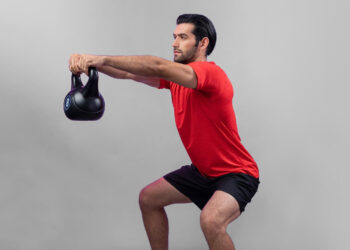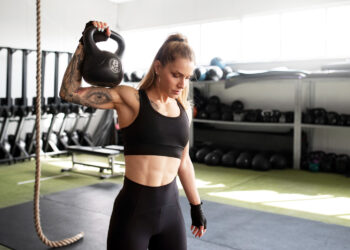I’ve been a personal trainer for over three decades. During that time, I’ve helped my clients reach numerous fitness goals, including prepping for bodybuilding and powerlifting competitions, training for triathlons and marathons, and recovering from illness or injury.
Needless to say, such specific goals have required some very specialist workouts and routines.
However, for every client who wanted to achieve something specific, I’ve probably worked with another 20 who just wanted “general fitness.” Invariably, this meant improving functional strength, building a little muscle, improving cardiovascular conditioning, and losing fat.
Such a diverse range of goals typically requires a combination of resistance and cardio training. In many cases, this means doing different workouts on different days, e.g.,
| Day | Workout |
|---|---|
| Monday | Full-Body Weights |
| Tuesday | LISS Cardio |
| Wednesday | Full-Body Weights |
| Thursday | HIIT Cardio |
| Friday | Full-Body Weights |
| Saturday | Fartlek Cardio |
| Sunday | Rest |
While such an approach is effective, it’s not practical for everyone. Some exercisers simply do not have the time to work out almost every day of the week.
The good news is that there is a training method that builds strength, increases muscle, boosts fitness, and burns fat all at the same time. I’m talking about circuit training with weights, also known as circuit weight training or CWT for short.
Level Up Your Fitness: Join our 💪 strong community in Fitness Volt Newsletter. Get daily inspiration, expert-backed workouts, nutrition tips, the latest in strength sports, and the support you need to reach your goals. Subscribe for free!
In this article, I lift the lid on this criminally underutilized training method and explain how to use it to achieve your fitness, strength, and body composition goals.
What is Circuit Training with Weights?
Weight training, more commonly called strength training, revolves around exercises like squats, bench presses, lat pulldowns, and leg presses. Participants perform each movement for a predetermined number of reps with a challenging but appropriate load.
Most conventional programs call for several sets of each exercise, interspersed with short rests, usually 1-2 minutes. You complete all the prescribed sets for one movement before moving on to the next. Trainers call this a horizontal program structure, e.g.:
| Exercise | Sets | Reps |
|---|---|---|
| Squat | 3 | 12-15 |
| Chest press | 3 | 12-15 |
| Seated row | 3 | 12-15 |
| Leg extension | 3 | 12-15 |
| Leg curl | 3 | 12-15 |
| Shoulder press | 3 | 12-15 |
| Lat pulldown | 3 | 12-15 |
| Cable crunch | 3 | 12-15 |
In contrast, circuit training uses a vertical structure, meaning exercises are done back-to-back with little or no rest in between. The exercises, called stations in circuit training, are then done for several rounds or laps.
Read more about circuit training here.
Regular circuit training typically involves several different exercise modalities, including body weight. In contrast, circuit training with weights utilizes the strength training equipment found in most commercial and home gyms.
So, instead of push-ups and air squats, which are staples of many circuit workouts, you do exercises like chest presses and hack squats instead.
For example:
Do 2-4 rounds of the following exercises, performing as many reps as possible in 45 seconds and resting 2-3 minutes between laps.
- Romanian deadlift
- Dumbbell bench press
- Bent-over barbell row
- Goblet squat
- Barbell overhead press
- Lat pulldown
- Barbell curl
- Triceps dip
Exercises, reps/time per station, the number of rounds, and the rest between rounds are all modifiable. This means you can adapt CWT to meet your needs, abilities, and goals.
Circuit Training with Weights Benefits and Advantages
So, why should you start doing circuit training with weights? Check out these proven benefits and advantages (1, 2, 3)!
Improved cardiorespiratory fitness – cardio activities like running and cycling are not the only way to boost cardiorespiratory fitness. Doing multiple strength training exercises back-to-back will also challenge and develop your heart, lungs, and circularity system. Improved cardiorespiratory fitness is strongly linked to better general health.
Increased strength and muscle mass – circuits typically involve light resistance and high reps. Subsequently, they’re very good for improving endurance but less effective for building muscle and strength.
In contrast, circuit training with weights allows you to use heavier loads, providing more overload for your muscles. This makes CWT better for strength and muscle gains than regular circuits.
Weight loss and body fat reduction – with more time spent exercising than resting, circuit training with weights uses a lot of energy. Paired with an appropriate diet, CWT can help you lose fat, get lean, and maintain your goal weight or body composition more easily.
Comprehensive training effect – where strength training builds muscle and cardio improves cardiorespiratory fitness, circuit training with weights targets both of these things at once. As such, instead of training 5-6 times per week, you can achieve similar benefits with just 2-3 weekly sessions.
Time-efficient workouts – most regular weight training workouts involve more time spent resting than exercising. The non-stop nature of circuit weight training means much less rest time. Subsequently, workouts are shorter, or you can do more training in the same duration.
Customizable workouts – you can modify circuit training with weights to match your needs, goals, and fitness level. You can also mix up your workouts to keep things fresh and interesting. This variability could make your workouts more appealing, enhancing exercise adherence.
Modifiable elements include:
- Choice of exercise (e.g., squats, leg press, lunges, or hack squats)
- Exercise equipment (dumbbells, barbells, resistance machines, resistance bands)
- Load (light, moderate, heavy)
- Exercise order
- Time or rep-controlled stations
- Transition time between stations
- Rest time between rounds
- Number of rounds
Changing these things means you can create an almost infinite number of workouts. This is a huge advantage to anyone who gets bored doing more repetitive workouts. It also means you can easily alter your planned workout if any of the equipment you want to use is unavailable.
Circuit Training with Weights Drawbacks
While circuit weight training offers plenty of benefits and advantages, there are a couple of drawbacks you also need to consider:
Level Up Your Fitness: Join our 💪 strong community in Fitness Volt Newsletter. Get daily inspiration, expert-backed workouts, nutrition tips, the latest in strength sports, and the support you need to reach your goals. Subscribe for free!
Difficulty picking the correct weights – choosing the right weights for circuit weight training is not always easy. Things like cardiovascular fatigue and station order will affect exercise performance. As such, you may need to adjust your weights during your workout and from one session to the next.
Not suitable for busy gyms – you won’t win any friends trying to do circuit training with weights in a busy gym. At best, you’ll be guilty of hogging a whole bunch of workout equipment. At worst, the equipment you want to use will be busy, and you won’t be able to do your planned workout.
Some gyms have dedicated areas for circuit training with weights, usually comprising resistance training machines. However, this is not always the case.
Not the best way to develop fitness, strength, or muscle mass – if you want to maximize one fitness component above the others, you need to emphasize it in your training. That’s why runners spend most of their time running, and bodybuilders put most of their energy into lifting. This is the fitness principle of specificity.
That’s not to say that circuit training with weights won’t build strength, muscle, or fitness – it will. However, you’ll probably progress better if you focus on one objective at a time.
All that said, circuit training with weights is one of the best ways to develop the general fitness that most exercisers want, i.e., a lean, strong, sculpted, fit physique.
Circuit Training with Weights – Workout Guide
Do you want to try circuit training with weights but aren’t sure where to start? Here is a guide to help you create your own CWT workouts!
Proper sequencing – the order of the exercises in your circuit has a huge impact on workout effectiveness and enjoyment. For example, if you do too many similar exercises in a row, fatigue will quickly set in, and you’ll have to reduce your weights or do fewer reps.
So, instead of grouping all your leg, chest, or back exercises together, separate them using a legs/push/pull/core order. This shifts the work from one area of your body to another, and each exercise provides an active rest from the one that preceded it.
For example:
- Walking lunge
- Chest press machine
- Bent-over row
- Plank
- Good morning
- Shoulder press machine
- Assisted pull-up
- Dead bug
- Squat jump
- Pec deck
- Upright row
- Reverse crunch
Choose between time and rep-controlled stations – some people prefer timed circuits, e.g., 45 seconds per exercise. In contrast, others prefer to do each exercise for reps. Both options can work, so it’s up to you which one you choose.
However, regardless of which you pick, make sure you select weights that mean you are starting to fatigue as you near the end of the exercise.
Also, note that you don’t have to do the same amount of work for all the rounds of your workout. For example, you might prefer to do your longest round first, gradually reducing the difficulty of your workout as you tire. For example:
- 1st round – 20 reps/60 seconds
- 2nd round – 15 reps/45 seconds
- 3rd round – 12 reps/30 seconds
Decide on your transitions – the faster you move between exercises, the more intense your workout will be.
Moving quickly between stations will increase your heart and breathing rate more, creating more of a cardiovascular workout. However, it may also reduce exercise performance, potentially limiting strength and muscle gains.
In contrast, resting 15-30 seconds between exercises will give you time to catch your breath so you can lift more weight or do more reps. However, your workout will lose some of the fitness-building effect. Modify your transitions according to your fitness and goals.
Plan how long you are going to rest between rounds – choose how long you’re going to rest before you do your next round. You can rest for a few minutes, e.g., 1-2, or wait until your heart rate drops below a certain level, such as 100 BPM.
Shorter rests will make subsequent laps harder, while longer rests mean you’ll probably be able to pump out more reps or use heavier loads.
Decide how many rounds you are going to do – you can do anywhere from one to many rounds of your circuit. The number of laps will depend on your fitness, the number of exercises in your workout, and how much time you have. Typically, the fewer stations in a circuit, the more laps you’ll do.
The number of laps is also flexible, and you can adjust it according to how you are feeling. You might do fewer laps if you are tired or more if your energy levels are higher than expected.
Make a note of what worked and what didn’t – even the most well-thought-out circuit with weights may not work the way you hoped. Avoid making the same mistakes twice by making notes about your workout.
With experience, you’ll get much better at planning circuits, and subsequent workouts will be more effective and enjoyable.
Circuit Training with Weights – Conclusion
Do you want to build muscle, get fit, and burn fat but don’t have time to do separate cardio and weights sessions? You are not alone! After all, lack of time is one of the most common barriers to exercise. Studies suggest many people don’t have time to work out regularly (4).
Circuit training with weights is the do-it-all exercise solution that saves time while maximizing results. It’s ideal for busy folk who cannot commit to daily workouts. While it may not be the best way to build muscle or boost fitness, it’s an effective way to develop all-around fitness and strength.
So, enough with the excuses! Circuit training with weights will deliver the results you want in much less time. Three short sessions a week should be all you need to improve cardio and muscular fitness and lose those unwanted pounds.
References:
- Ramos-Campo DJ, Andreu-Caravaca L, Carrasco-Poyatos M, Benito PJ, Rubio-Arias JÁ. Effects of Circuit Resistance Training on Body Composition, Strength, and Cardiorespiratory Fitness in Middle-Aged and Older Women: A Systematic Review and Meta-Analysis. J Aging Phys Act. 2021 Oct 9;30(4):725-738. doi: 10.1123/japa.2021-0204. PMID: 34627129.
- Gettman LR, Pollock ML. Circuit Weight Training: A Critical Review of Its Physiological Benefits. Phys Sportsmed. 1981 Jan;9(1):44-60. doi: 10.1080/00913847.1981.11710988. PMID: 27462744.
- Ramos-Campo DJ, Andreu Caravaca L, Martínez-Rodríguez A, Rubio-Arias JÁ. Effects of Resistance Circuit-Based Training on Body Composition, Strength and Cardiorespiratory Fitness: A Systematic Review and Meta-Analysis. Biology (Basel). 2021 Apr 28;10(5):377. doi: 10.3390/biology10050377. PMID: 33924785; PMCID: PMC8145598.
- Gjestvang C, Abrahamsen F, Stensrud T, Haakstad LAH. Motives and barriers to initiation and sustained exercise adherence in a fitness club setting-A one-year follow-up study. Scand J Med Sci Sports. 2020 Sep;30(9):1796-1805. doi: 10.1111/sms.13736. Epub 2020 Jun 15. PMID: 32488898; PMCID: PMC7497044.











